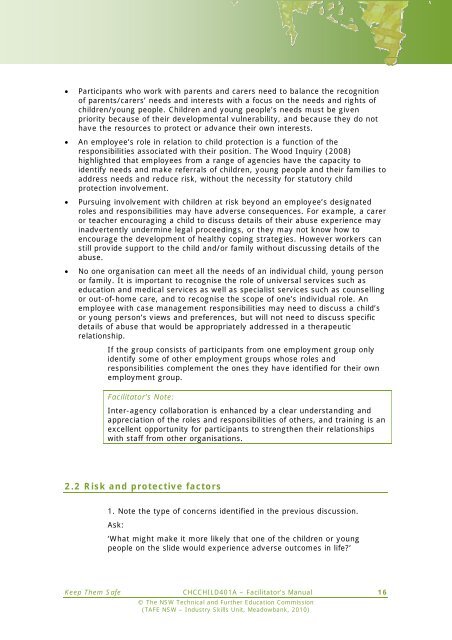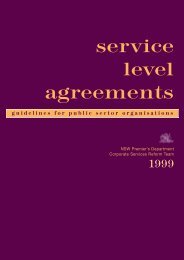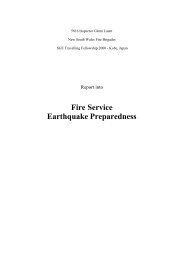Identify and respond to children and young people at risk - NSW ...
Identify and respond to children and young people at risk - NSW ...
Identify and respond to children and young people at risk - NSW ...
Create successful ePaper yourself
Turn your PDF publications into a flip-book with our unique Google optimized e-Paper software.
Participants who work with parents <strong>and</strong> carers need <strong>to</strong> balance the recognition<br />
of parents/carers’ needs <strong>and</strong> interests with a focus on the needs <strong>and</strong> rights of<br />
<strong>children</strong>/<strong>young</strong> <strong>people</strong>. Children <strong>and</strong> <strong>young</strong> <strong>people</strong>’s needs must be given<br />
priority because of their developmental vulnerability, <strong>and</strong> because they do not<br />
have the resources <strong>to</strong> protect or advance their own interests.<br />
An employee’s role in rel<strong>at</strong>ion <strong>to</strong> child protection is a function of the<br />
responsibilities associ<strong>at</strong>ed with their position. The Wood Inquiry (2008)<br />
highlighted th<strong>at</strong> employees from a range of agencies have the capacity <strong>to</strong><br />
identify needs <strong>and</strong> make referrals of <strong>children</strong>, <strong>young</strong> <strong>people</strong> <strong>and</strong> their families <strong>to</strong><br />
address needs <strong>and</strong> reduce <strong>risk</strong>, without the necessity for st<strong>at</strong>u<strong>to</strong>ry child<br />
protection involvement.<br />
Pursuing involvement with <strong>children</strong> <strong>at</strong> <strong>risk</strong> beyond an employee’s design<strong>at</strong>ed<br />
roles <strong>and</strong> responsibilities may have adverse consequences. For example, a carer<br />
or teacher encouraging a child <strong>to</strong> discuss details of their abuse experience may<br />
inadvertently undermine legal proceedings, or they may not know how <strong>to</strong><br />
encourage the development of healthy coping str<strong>at</strong>egies. However workers can<br />
still provide support <strong>to</strong> the child <strong>and</strong>/or family without discussing details of the<br />
abuse.<br />
No one organis<strong>at</strong>ion can meet all the needs of an individual child, <strong>young</strong> person<br />
or family. It is important <strong>to</strong> recognise the role of universal services such as<br />
educ<strong>at</strong>ion <strong>and</strong> medical services as well as specialist services such as counselling<br />
or out-of-home care, <strong>and</strong> <strong>to</strong> recognise the scope of one’s individual role. An<br />
employee with case management responsibilities may need <strong>to</strong> discuss a child’s<br />
or <strong>young</strong> person’s views <strong>and</strong> preferences, but will not need <strong>to</strong> discuss specific<br />
details of abuse th<strong>at</strong> would be appropri<strong>at</strong>ely addressed in a therapeutic<br />
rel<strong>at</strong>ionship.<br />
If the group consists of participants from one employment group only<br />
identify some of other employment groups whose roles <strong>and</strong><br />
responsibilities complement the ones they have identified for their own<br />
employment group.<br />
Facilita<strong>to</strong>r’s Note:<br />
Inter-agency collabor<strong>at</strong>ion is enhanced by a clear underst<strong>and</strong>ing <strong>and</strong><br />
appreci<strong>at</strong>ion of the roles <strong>and</strong> responsibilities of others, <strong>and</strong> training is an<br />
excellent opportunity for participants <strong>to</strong> strengthen their rel<strong>at</strong>ionships<br />
with staff from other organis<strong>at</strong>ions.<br />
2.2 Risk <strong>and</strong> protective fac<strong>to</strong>rs<br />
1. Note the type of concerns identified in the previous discussion.<br />
Ask:<br />
‘Wh<strong>at</strong> might make it more likely th<strong>at</strong> one of the <strong>children</strong> or <strong>young</strong><br />
<strong>people</strong> on the slide would experience adverse outcomes in life?’<br />
Keep Them Safe CHCCHILD401A – Facilita<strong>to</strong>r’s Manual<br />
© The <strong>NSW</strong> Technical <strong>and</strong> Further Educ<strong>at</strong>ion Commission<br />
(TAFE <strong>NSW</strong> – Industry Skills Unit, Meadowbank, 2010)<br />
16







